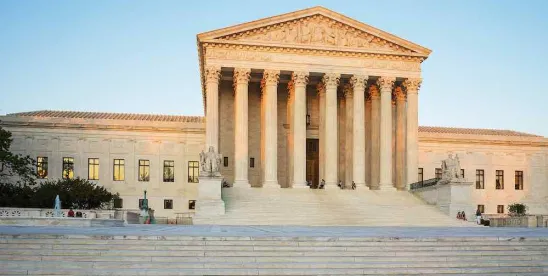The U.S. Supreme Court recently decided United States v. Miller, which resolved a circuit split over whether a trustee could avoid federal tax payments under section 544(b) of the United States Bankruptcy Code.[1] In this case, a trustee utilized section 544(b) to claw back tax payments under Utah’s state fraudulent transfer statute. Ordinarily, an action under Utah law against the federal government would be barred by sovereign immunity; however, section 106(a) of Bankruptcy Code contains a waiver of sovereign immunity with respect to section 544(b). Despite this, the Supreme Court held that the sovereign immunity waiver under section 106(a) only applies to section 544 itself, and not to the state-law claims “nested” within the statute.
Background
The underlying facts of the case concerned a Utah-based transportation company, All Resort Group, which became insolvent in 2013 following financial struggles and the misappropriation of company funds by two of its shareholders. In 2014, these shareholders transferred $145,000 of company funds to the IRS to pay for their personal income tax obligations. In 2017, All Resort Group filed for bankruptcy. Shortly thereafter, the trustee sued the United States under section 544(b) seeking to avoid the 2014 tax payments as fraudulent transfers under Utah state law. The United States argued that sovereign immunity prevented the trustee’s cause of action under Utah law, while the trustee argued that section 106(a) waived the government’s sovereign immunity with respect to section 544(b). The parties cross-moved for summary judgment. The Bankruptcy Court for the District of Utah entered judgment for the trustee, holding that sovereign immunity did not preclude the trustee from suing because of the waiver under section 106(a). The District Court and the Tenth Circuit affirmed the Bankruptcy Court’s decision. This further entrenched a circuit split where the Fourth and Ninth Circuits had previously sided with a trustee, while the Seventh Circuit had sided with the government—and the Supreme Court granted certiorari.
Avoidance Powers
Under chapter 5 of the Bankruptcy Code, trustees have avoidance powers that permit a trustee to recover certain assets for the benefit of the bankruptcy estate. There is a strong policy justification for these avoidance powers, because they enable trustees to equalize distributions among creditors, and prevent debtors from offloading assets to preferred creditors on the eve of bankruptcy. Specifically, section 544(b) permits a trustee to “avoid any transfer of an interest of the debtor . . . that is voidable under applicable law by a creditor holding an unsecured claim.” 11 U.S.C. § 544(b)(1). State laws, like the Uniform Voidable Transfers Act and the Uniform Fraudulent Transfer Act, provide a common basis for a trustee to invoke section 544(b) and generally provide creditors with a cause of action to invalidate fraudulent transfers.
The Interplay between Sections 106 and 544
The crux of the dispute involved how broad section 106(a) of the Bankruptcy Code may be. The relevant portions of section 106(a) read: “sovereign immunity is abrogated as to a government unit to the extent set forth in this section with respect to . . . (1) section[] 544,” and “(5) [n]othing in this section shall create any substantive claim for relief or cause of action not otherwise existing under this title, the Federal Rules of Bankruptcy Procedure, or nonbankruptcy law.” The trustee argued that section 106 provided a broad waiver of sovereign immunity for both section 544(b) and the “applicable law” invoked by this section, whereas the government argued the waiver applied only to section 544(b) itself and did not extend to the “applicable law” nested within section 544(b). According to the majority, the government had the better reading.
The Supreme Court explained that section 544(b) requires a bankruptcy trustee to identify an actual creditor who could have set aside the transaction under applicable law. If there is no actual creditor who could have set aside the transaction, then the trustee is prohibited from avoiding the transaction. In this case, no actual creditor would be able to avoid the federal tax payment under Utah law (because of sovereign immunity), and therefore, section 106(a) cannot provide a backdoor into creating liability for the government. The Court explained that the legislative history bolsters this reading, quoting the relevant House and Senate Reports, which provide “the policy followed here is designed to achieve approximately the same result that would prevail outside of bankruptcy.” The Court cited other sovereign immunity precedents for the proposition that sovereign immunity waivers are typically jurisdictional in nature and concluded that construing section 106(a) as applying to and modifying the elements of section 544(b) would be a “highly unusual understanding of sovereign-immunity waivers.” The Court also explained that the text of section 106(a)—that it does not “create any substantive claim for relief or cause of action not otherwise existing”—plainly refutes the argument that section 106(a) extends to both section 544(b) and its elements (the underlying “applicable law”).
In sum, the Supreme Court held that while section 106(a) abrogates sovereign immunity for causes of action under section 544(b), it did not abrogate sovereign immunity under the state-law claim that supplied the “applicable law” under section 544(b).
The Dissent
In a short dissent, Justice Gorsuch reasoned that because the parties did not dispute that a fraudulent transfer claim existed under Utah law, the “applicable law” element of section 544(b) was satisfied, even though the defendant was the federal government. In Justice Gorsuch’s view, sovereign immunity would operate as an affirmative defense to such a suit, but that here, the waiver in section 106(a) prohibited the government from raising this defense. Justice Gorsuch reasoned that applying the section 106(a) waiver to the “applicable law” did not “modify the elements” of 544(b) and concluded that trustees should be permitted to avoid fraudulent transfers to the federal government.
Observations and Takeaways
The majority opinion drives the point home that the key analysis of section 544(b) is whether an actual creditor could prevail against a party outside of bankruptcy, despite the term “actual” not appearing in section 544(b)’s text. Here, since an actual creditor would not prevail against the federal government outside of bankruptcy because of sovereign immunity, the Trustee could not maintain a claim. This ruling will provide guidance to attorneys engaged in disputes even outside of the sovereign immunity context, as it reinforces that a trustee cannot succeed in bringing an avoidance action pursuant to state law if an existing creditor cannot prevail under that law.
Interestingly, the Supreme Court’s holding can be read to be in direct tension with the fundamental principle of bankruptcy that creditors in equal positions should be treated equally—meaning, in this context, that prepetition transfers to preferred creditors should be prohibited. Indeed, preventing these and making such transfers also available to other creditors is the entire purpose of a trustee’s avoidance powers.
[1] U.S. v. Miller, 604 U.S. ___ (2025).




 />i
/>i
